 |
| plants text index | photo index |
| mangroves |
| Sonneratia Sonneratia sp. Family Lythraceae updated Jan 2013 Where seen? On our shores, the Perepat (Sonneratia alba) is commonly seen on the seaward side of mangroves, often forming majestic large tall trees. According to Corners, these trees are found in all tropical shores of the Eastern hemisphere from East Africa to the Pacific. There are four species in Malaya. Hybrids among S. alba, S. caseolaris and S. ovata have been found in Brunei and may occur in Malaya. According to Tomlinson, these trees are found from East Africa through Indo-Malaya to tropical Australia and into Micronesia and Melanesia. Typically growing on the seaward fringe. It is sometimes referred to as the firefly mangrove because these insects gather on the trees at night. Formerly placed in Family Sonneratiaceae. Features: The produce sturdy conical pneumatophores, although those growing in hard surfaces may not produce so many. The flowers are fluffy made up of a pom-pom white stamens in a cup-shaped calyx. These turn into globular fruits seated on a star-like calyx with the seeds embedded in the pulp. Leaves are thick and leathery. The flowers open at dusk emitting a smell of sour milk or butter and last only one night. They are pollinated by bats which drink the nectar in the calyx-cup. Where bats are uncommon, hawk moths are an alternative visitor. Honeybirds have also been seen drinking this nectar at dawn and at dusk. According to Burkill, the fruits are sought by monkey and the Proboscis monkey lives largely on them and on the leaves. No durians without mangroves! According to Tomlinson, a study in west Malaysia found that Durian flowers are pollinated almost entirely by a single species of bat Eonycterus spelaea. This bat roosts primarily in limestone caves and are fast flyers that range up to 50km each night in search of pollen and nectar from a wide variety of plants. Their range include mangroves and Sonneratia species especially S. alba are important sources of food for these bats. According to Tomlinson, in Malaysia, several species of nectar-feeding bats are responsible for the pollination of Sonneratia. One of them, the Common long-tongued nectar bat (Macroglossus minimus) is said to be dependent on Sonneratia as its main food source, and this bat has never been recorded away from mangroves. In Singapore, this bat is known in the mangroves of Pulau Ubin, Pulau Tekong and also at Sungei Buloh where it feeds on the nectar of Berembang (Sonneratia caseolaris) and Perepat (Sonneratia alba) trees, as well as durian, jambu and banana trees. The bat feeds on the nectar with its brush-like tongue, in the processing getting dusted by pollen which it transfers to the next flower that it feeds on. Fiery Tree: According to the NParks Flora and Fauna website, Berembang (Sonneratia caseolaris) is where adult "fireflies" flock and flash in a synchronised manner, famous in places such as Selangor. These animals are actually a bettle (Pteroptyx tener). The Berembang's exact relationship with firefly is unknown. The adults is believed to feed on either the tree's sap, young leaves, flower nectar or scale insects specific to the tree, and prefer the open canopy of the tree which allows their flashing displays to be seen from long distances.Their larvae are carnivorous and amphibious, nesting in the vegetation below tree, feeding on aquatic snails (Cyclotropis carinata) and nematode worms. Fireflies are also associated with other Sonneratia species and other mangrove trees. In Singapore, a different firefly beetle species is found, Pteroptyx valida which doesn't flash in a synchronised manner and is found in other kinds of mangrove trees. |
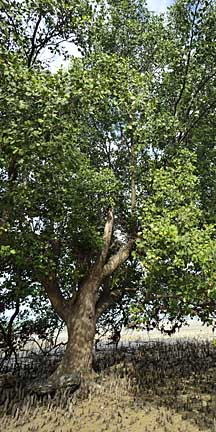 Pulau Semakau, Jan 09 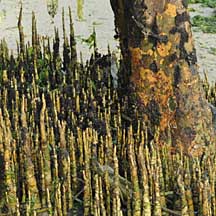 Conical pneumatophores. Pasir Ris, May 09 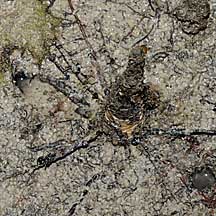 Side roots from the pneumatophore. Pulau Semakau, Dec 08 |
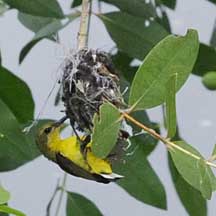 Sunbird nesting in Berembang. Pasir Ris Park, Jan 10 |
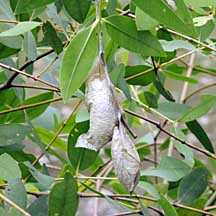 Atlas moth cocoon on Berembang. Pasir Ris Park, Jan 10 |
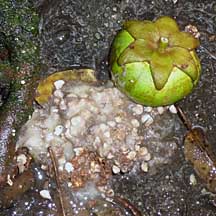 Ripe fruit falls and splits open releasing seeds. Kranji Nature Trail, Jun 11 |
| Sonneratia species on Singapore shores |
|
Perepat
Sonneratia alba |
Berembang
Sonneratia caseolaris |
Gedabu
Sonneratia ovata |
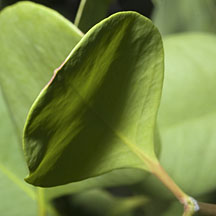 |
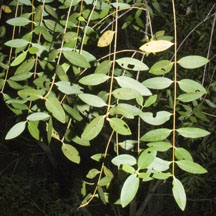 |
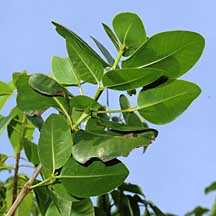 |
|
Young
leaves are pale green with
faint pink tinge at the leaf 'tip'. |
Young
branches hang down like
those of the weeping willow. |
Leaves
not narrow at the base,
not pink at the tips. |
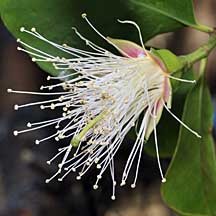
|
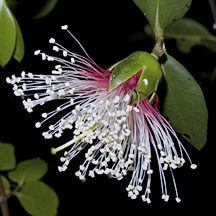
|
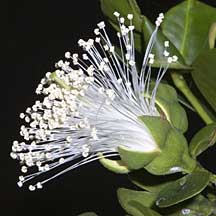 |
|
Petals
white, inconspicuous.
Stamens white. |
Petals
red, inconspicuous.
Stamen pinkish at the base. |
No
petals.
Stamens white. |
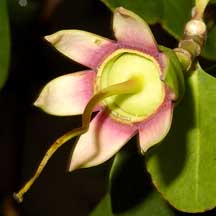
|
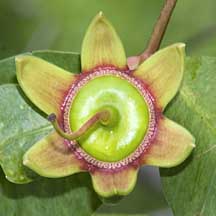 |
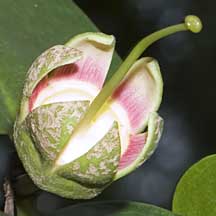 |
|
Sepals
pinkish or red on the inside.
|
Sepals
yellowish green on the inside.
|
Sepals
pinkish or red on the inside.
|
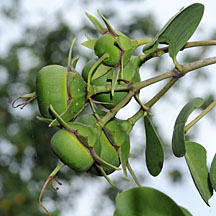
|
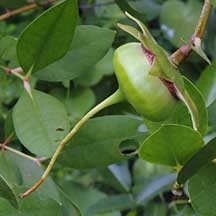 |
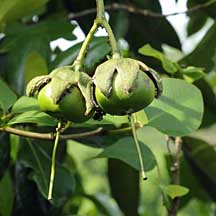 |
|
Calyx
lobes bend away
from the fruit towards the stalk |
Calyx
lobes flat,
spreading out horizontally, tips may bend slighting towards the fruit. |
Calyx
lobes clasp the fruit.
|
|
Links
References
|
|
|